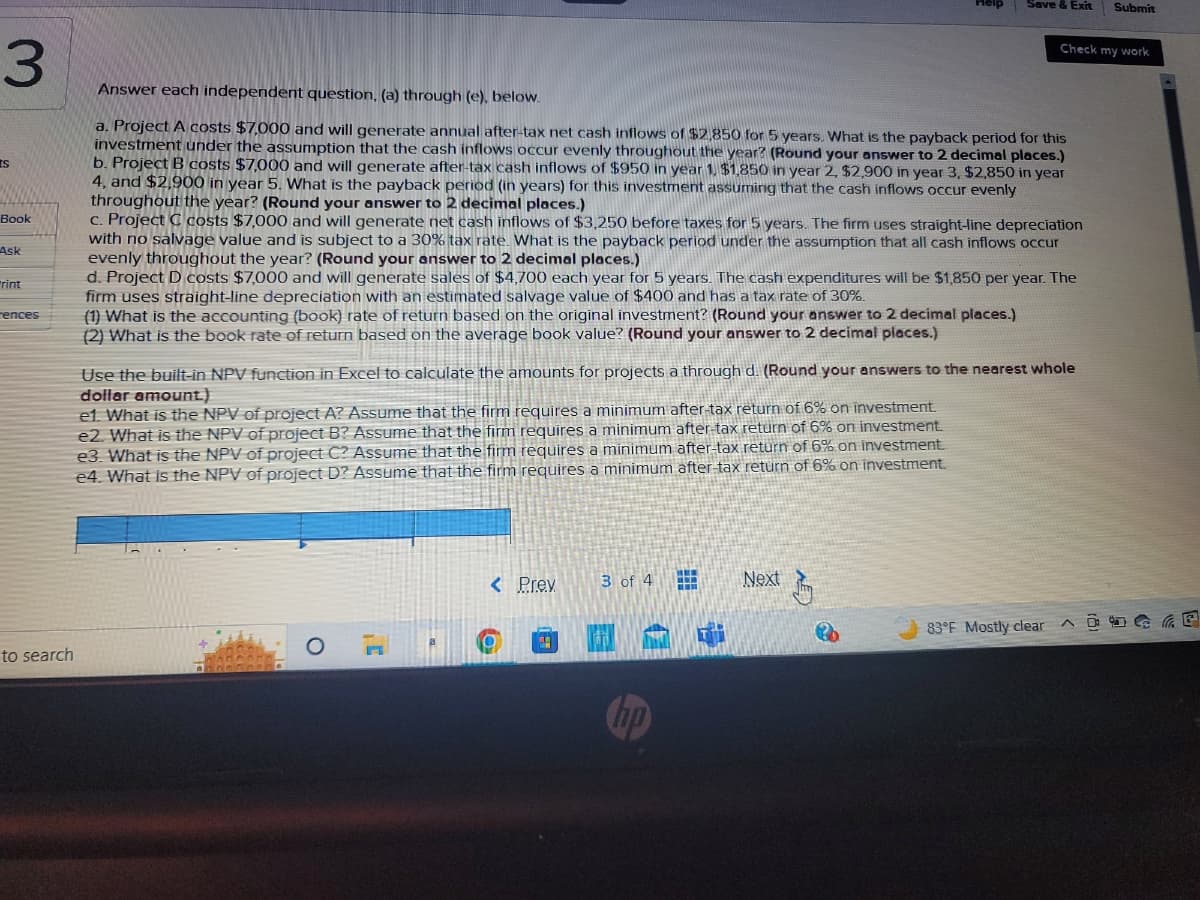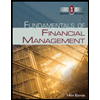a. Project A costs $7,000 and will generate annual after-tax net cash inflows of $2,850 for 5 years. What is the payback period for this investment under the assumption that the cash inflows occur evenly throughout the year? (Round your answer to 2 decimal places.) . Project B costs $7,000 and will generate after-tax cash inflows of $950 in year 1, $1,850 in year 2, $2,900 in year 3, $2,850 in year 4, and $2,900 in year 5. What is the payback period (in years) for this investment assuming that the cash inflows occur evenly hroughout the year? (Round your answer to 2 decimal places.) c. Project C costs $7,000 and will generate net cash inflows of $3,250 before taxes for 5 years. The firm uses straight-line depreciation with no salvage value and is subject to a 30% tax rate. What is the payback period under the assumption that all cash inflows occur evenly throughout the year? (Round your answer to 2 decimal places.) 1. Project D costs $7,000 and will generate sales of $4,700 each year for 5 years. The cash expenditures will be $1,850 per year. The rm uses straight-line depreciation with an estimated salvage value of $400 and has a tax rate of 30%. What is the accounting (book) rate of return based on the original investment? (Round your answer to 2 decimal places.) 2) What is the book rate of return based on the average book value? (Round your answer to 2 decimal places.) se the built-in NPV function in Excel to calculate the amounts for projects a through d. (Round your answers to the nearest whole ollar amount.) What is the NPV of project A? Assume that the firm requires a minimum after-tax return of 6% on investment. 2. What is the NPV of project B? Assume that the firm requires a minimum after-tax return of 6% on investment. What is the NPV of project C? Assume that the firm requires a minimum after-tax return of 6% on investment. - What is the NPV of project D? Assume that the firm requires a minimum after tax return of 6% on investment.
a. Project A costs $7,000 and will generate annual after-tax net cash inflows of $2,850 for 5 years. What is the payback period for this investment under the assumption that the cash inflows occur evenly throughout the year? (Round your answer to 2 decimal places.) . Project B costs $7,000 and will generate after-tax cash inflows of $950 in year 1, $1,850 in year 2, $2,900 in year 3, $2,850 in year 4, and $2,900 in year 5. What is the payback period (in years) for this investment assuming that the cash inflows occur evenly hroughout the year? (Round your answer to 2 decimal places.) c. Project C costs $7,000 and will generate net cash inflows of $3,250 before taxes for 5 years. The firm uses straight-line depreciation with no salvage value and is subject to a 30% tax rate. What is the payback period under the assumption that all cash inflows occur evenly throughout the year? (Round your answer to 2 decimal places.) 1. Project D costs $7,000 and will generate sales of $4,700 each year for 5 years. The cash expenditures will be $1,850 per year. The rm uses straight-line depreciation with an estimated salvage value of $400 and has a tax rate of 30%. What is the accounting (book) rate of return based on the original investment? (Round your answer to 2 decimal places.) 2) What is the book rate of return based on the average book value? (Round your answer to 2 decimal places.) se the built-in NPV function in Excel to calculate the amounts for projects a through d. (Round your answers to the nearest whole ollar amount.) What is the NPV of project A? Assume that the firm requires a minimum after-tax return of 6% on investment. 2. What is the NPV of project B? Assume that the firm requires a minimum after-tax return of 6% on investment. What is the NPV of project C? Assume that the firm requires a minimum after-tax return of 6% on investment. - What is the NPV of project D? Assume that the firm requires a minimum after tax return of 6% on investment.
Fundamentals of Financial Management (MindTap Course List)
15th Edition
ISBN:9781337395250
Author:Eugene F. Brigham, Joel F. Houston
Publisher:Eugene F. Brigham, Joel F. Houston
Chapter12: Cash Flow Estimation And Risk Analysis
Section: Chapter Questions
Problem 16P: REPLACEMENT CHAIN The Lesseig Company has an opportunity to invest in one of two mutually exclusive...
Related questions
Question
100%

Transcribed Image Text:3
IS
Book
Ask
rint
rences
to search
Answer each independent question, (a) through (e), below.
a. Project A costs $7,000 and will generate annual after-tax net cash inflows of $2,850 for 5 years. What is the payback period for this
investment under the assumption that the cash inflows occur evenly throughout the year? (Round your answer to 2 decimal places.)
b. Project B costs $7,000 and will generate after-tax cash inflows of $950 in year 1, $1,850 in year 2, $2,900 in year 3, $2,850 in year
4, and $2,900 in year 5. What is the payback period (in years) for this investment assuming that the cash inflows occur evenly
throughout the year? (Round your answer to 2 decimal places.)
c. Project C costs $7,000 and will generate net cash inflows of $3,250 before taxes for 5 years. The firm uses straight-line depreciation
with no salvage value and is subject to a 30% tax rate. What is the payback period under the assumption that all cash inflows occur
evenly throughout the year? (Round your answer to 2 decimal places.)
d. Project D costs $7,000 and will generate sales of $4,700 each year for 5 years. The cash expenditures will be $1,850 per year. The
firm uses straight-line depreciation with an estimated salvage value of $400 and has a tax rate of 30%.
(1) What is the accounting (book) rate of return based on the original investment? (Round your answer to 2 decimal places.)
(2) What is the book rate of return based on the average book value? (Round your answer to 2 decimal places.)
O
Use the built-in NPV function in Excel to calculate the amounts for projects a through d. (Round your answers to the nearest whole
dollar amount.)
e1. What is the NPV of project A? Assume that the firm requires a minimum after-tax return of 6% on investment.
e2. What is the NPV of project B? Assume that the firm requires a minimum after-tax return of 6% on investment.
e3. What is the NPV of project C? Assume that the firm requires a minimum after-tax return of 6% on investment.
e4. What is the NPV of project D? Assume that the firm requires a minimum after-tax return of 6% on investment.
E
< Prev
19
Save & Exit
3 of 4
Next
Check my work
Jay
Submit
83°F Mostly clear AG
Expert Solution
This question has been solved!
Explore an expertly crafted, step-by-step solution for a thorough understanding of key concepts.
This is a popular solution!
Trending now
This is a popular solution!
Step by step
Solved in 2 steps

Knowledge Booster
Learn more about
Need a deep-dive on the concept behind this application? Look no further. Learn more about this topic, finance and related others by exploring similar questions and additional content below.Recommended textbooks for you

Fundamentals of Financial Management (MindTap Cou…
Finance
ISBN:
9781337395250
Author:
Eugene F. Brigham, Joel F. Houston
Publisher:
Cengage Learning

Fundamentals of Financial Management (MindTap Cou…
Finance
ISBN:
9781285867977
Author:
Eugene F. Brigham, Joel F. Houston
Publisher:
Cengage Learning


Fundamentals of Financial Management (MindTap Cou…
Finance
ISBN:
9781337395250
Author:
Eugene F. Brigham, Joel F. Houston
Publisher:
Cengage Learning

Fundamentals of Financial Management (MindTap Cou…
Finance
ISBN:
9781285867977
Author:
Eugene F. Brigham, Joel F. Houston
Publisher:
Cengage Learning


Managerial Accounting
Accounting
ISBN:
9781337912020
Author:
Carl Warren, Ph.d. Cma William B. Tayler
Publisher:
South-Western College Pub

Principles of Accounting Volume 2
Accounting
ISBN:
9781947172609
Author:
OpenStax
Publisher:
OpenStax College

Intermediate Financial Management (MindTap Course…
Finance
ISBN:
9781337395083
Author:
Eugene F. Brigham, Phillip R. Daves
Publisher:
Cengage Learning